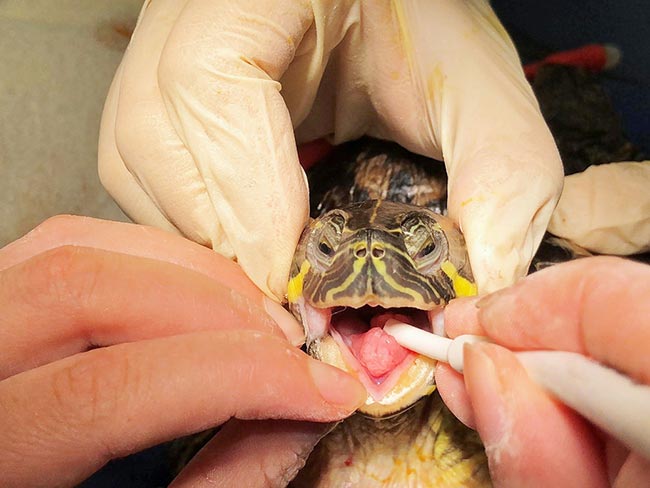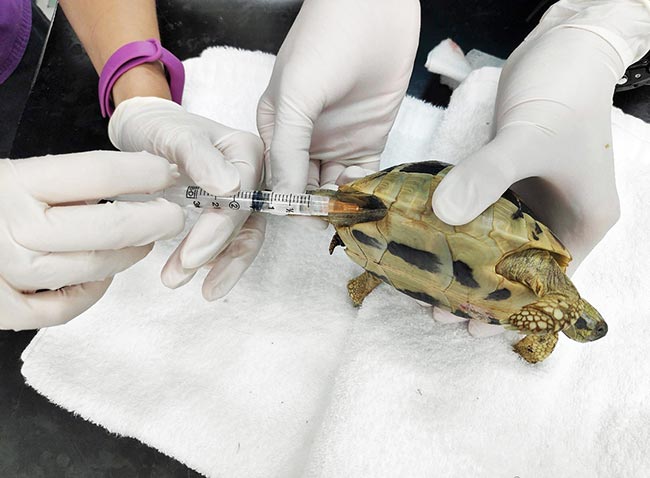23 Jun 2020
Violaine Colon details the case of a 60-year-old male that was unresponsive and apnoeic after being recovered from this location.

Image: © pedro / Adobe Stock
A 60-year-old Hermann’s tortoise was found at the bottom of a pond after being missing for two days. The reptile was unresponsive and apnoeic on arrival to the clinic. Critical care was investigated (intubation, assisted breathing and warming the patient to the preferred optimal temperature zone) and spontaneous breathing resumed. After a few days of hospitalisation, the tortoise made a full recovery.
This case report confirms that reptiles have the capacity of surviving a long period of apnoea.
Tortoises with free access outdoors are at risk of various accidental injuries.
This case illustrates an instance where a tortoise had been recovered from a pond. Treatment is discussed along with the challenge in this species of determining whether a tortoise is dead.
A 60-year-old male Hermann’s tortoise (Testudo hermanni) weighing 1.1kg was presented.
The tortoise had been missing for two days. It was found at the bottom of a pond in the owner’s garden.
The tortoise was normally kept in the garden, with no access to a heat lamp or UV light. Hibernation was allowed every year. Diet consisted mainly of fresh leafy greens and the tortoise was allowed to graze in the garden.
On admission, the tortoise was cold, unresponsive and not breathing. A heartbeat was present at 28 beat/min and slight reflexes (corneal and withdraw reflexes) were present.
Otherwise, the tortoise was in good body condition, and the rest of the clinical examination was unremarkable. See Panel 1 for how to know if a tortoise is dead.
Brain death can be challenging to identify in chelonians.
The criteria on which a diagnosis of brain death can be made includes “absolute unresponsiveness to external stimuli; cessation of movement and breathing, including no spontaneous breathing for three minutes after an artificial respirator has been turned off; and complete absence of cephalic reflexes. The pupils of the eyes must be dilated and unresponsive to direct light” (Studdert et al, 2006).
Practical methods:
The tortoise was intubated (Panel 2) and connected to intermittent positive pressure ventilation to ventilate with oxygen at a breathing rate of five breaths per minute.

The tortoise was warmed by using an air blanket and warmed intracoelomic fluids (Hartmann‘s solution) were given to correct daily requirements (10ml/kg/day to 30ml/kg/day).
The tortoise was then monitored for the next 12 hours and kept hospitalised in a room with an ambient temperature of 24°C, and under a heat lamp at 30°C.
After a few hours on the ventilator, manual breathing was performed with room air using a bag valve mask.
The main stimulus to breathe in reptiles is low levels of oxygen in the blood (Longley, 2008). Overventilation can cause further respiratory depression by raising the partial pressure of oxygen (Long, 2016).
After five hours, the tortoise started breathing on its own and was extubated. The next morning, it was reactive, bright and alert. The tortoise was started on a course of prophylactic antibiotic (ceftazidime 22mg/kg every 72 hours) by IM injection to cover for possible aspiration pneumonia.
The tortoise was kept hospitalised for the next couple of days and continued to improve. Supportive care (fluids and assisted feeding with a critical care herbivore fine grind recovery food at a dose of 20ml/kg; Norton, 2005) was provided. It started eating dark green vegetables after 48 hours.
Blood test for haematology and biochemistry were performed to check for any underlying conditions, which did not reveal any abnormalities.
Radiology was not performed as, in acute cases, lung changes are unlikely to be visible (Chitty and Raftery, 2013). In more chronic cases, lung consolidation (caused by fibrosis, neoplasia, inflammation or infection) can be observed as an increase in lung opacity (Hernandez-Divers, 2006).
After five days of hospitalisation, the tortoise was discharged with ceftazidime injections to continue the antibiotic course.

At a follow-up appointment, the tortoise was doing well.
Chelonians have the ability to lower their metabolism (Chitty and Raftery, 2013). They can also switch to dive reflex, anaerobic respiration and cardiac shunting, which allow them to tolerate hypoxia (Schumacher, 2003; O’Malley, 2005).
Long (2016) wrote: “Apnoea, bradycardia, diving or lung disease can increase pulmonary resistance, inducing the right‑to‑left cardiac shunting and directing blood flow from the right to left ventricles, bypassing the lungs. The physiologic advantage of shunting is that it allows the continual circulation and delivery of oxygen to the tissues during apnoea.”
This explains how tortoises have a high survival rate after falling into ponds, even after a few hours.
When presented with an unresponsive tortoise, apply the following steps.
Warm the tortoise slowly to the preferred optimal temperature zone (POTZ) temperature (25°C to 30°C for most Mediterranean species).
Chelonians are ectothermic and depend on the environmental temperature to maintain their body temperature. POTZ is the temperature range where the tortoise can function optimally overall (Norton, 2005). Temperature will influence heart rate, respiratory rate and physiological functions. Heart rate will increase with temperature (Longley, 2008).
Warmth can be provided by different methods, such as:
Temperature should be measured – especially if the tortoise is not responding – and care should be taken not to overheat the patient.
Principles of resuscitation are the same as other animals: airway, breathing and circulation.
More details on how to treat critical tortoise can be found in the literature.